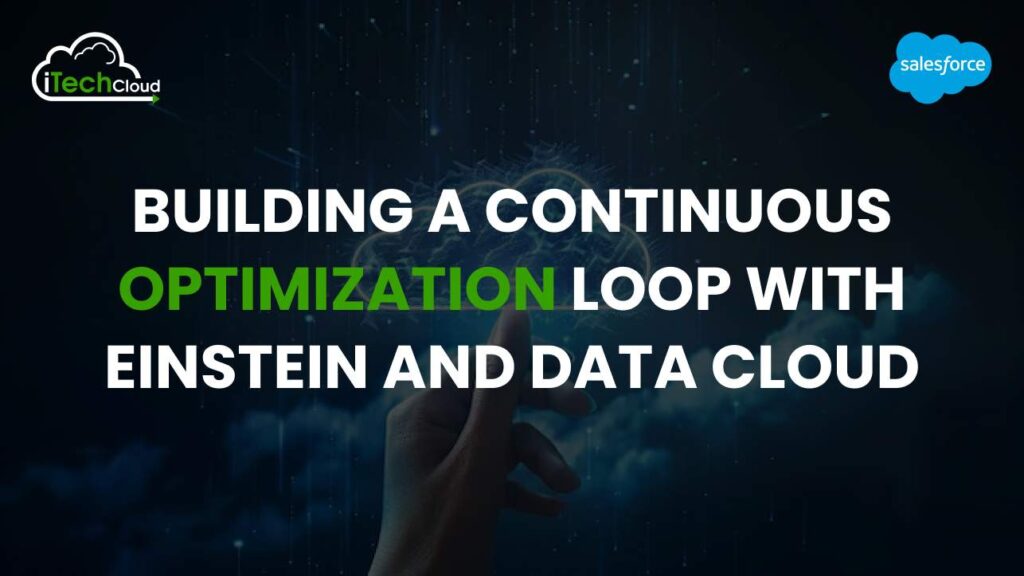Building a Continuous Optimization Loop with Einstein and Data Cloud

Creating a continuous optimization loop with Einstein and Data Cloud involves integrating advanced artificial intelligence with robust data management capabilities to drive ongoing improvements in business processes. This blog will delve into the comprehensive steps and components required to build such a loop, emphasizing data integration, predictive analytics, automated actions, and the iterative nature of optimization.
Introduction
In today’s rapidly evolving business landscape, organizations face increasing pressure to optimize operations continuously. The combination of Salesforce’s Einstein AI and Data Cloud offers a powerful solution to achieve this goal. This blog explores how these technologies can be leveraged to create a dynamic optimization loop, enhancing decision-making, efficiency, and customer satisfaction.
Table of Contents
Understanding Einstein and Data Cloud
Einstein AI
Salesforce’s Einstein AI is a suite of machine learning and artificial intelligence tools embedded within the Salesforce platform. It enables businesses to analyze data, uncover insights, predict outcomes, and automate tasks, thereby enhancing productivity and driving growth.
Data Cloud
Data Cloud serves as Salesforce’s comprehensive data management platform, facilitating data integration, cleansing, and unification from various sources. It provides a unified view of data to support informed decision-making and operational efficiency.
Steps to Building a Continuous Optimization Loop
Step 1: Data Integration and Preparation
Data Collection
The foundation of any optimization loop is data. Organizations must collect relevant data from disparate sources such as CRM systems, IoT devices, social media, and transactional databases. Data Cloud simplifies this process with pre-built connectors and APIs, enabling seamless data ingestion.
Data Cleansing and Unification
Once collected, data often requires cleansing and integration to ensure accuracy and consistency. Einstein and Data Cloud data management capabilities allow businesses to cleanse, match, and unify data from multiple sources into a single, coherent dataset. This unified data forms the basis for meaningful analysis and predictive modeling.
Step 2: Data Analysis and Insight Generation
Exploratory Data Analysis (EDA)
Before applying advanced analytics, it’s crucial to explore and understand the data through EDA. Visualization tools integrated with Data Cloud, such as Tableau, help identify patterns, correlations, and outliers within the dataset. This exploration phase guides subsequent modeling efforts.
Predictive Modeling with Einstein
Einstein AI offers a variety of predictive modeling techniques, including regression, classification, and clustering. Organizations can select the most appropriate model based on their specific business objectives, whether predicting customer churn, sales forecasting, or optimizing inventory levels.
Model Training and Validation
Once a model is chosen, it undergoes training using historical data. This process involves splitting the dataset into training and validation sets to evaluate the model’s performance and accuracy. Einstein and Data Cloud automates much of this process, leveraging its algorithms to optimize model training and validation.
Deployment and Integration
After successful training and validation, the predictive model is deployed within the Salesforce ecosystem. Integration with Salesforce applications allows organizations to operationalize insights directly into their business processes. For instance, predictive lead scoring can prioritize sales efforts, while predictive maintenance alerts can optimize service schedules.
Step 3: Automated Actions and Decision Making
Intelligent Recommendations and Actions
With predictive models in place, organizations can automate decision-making processes. Einstein AI generates intelligent recommendations based on real-time data, enabling personalized customer interactions, proactive maintenance strategies, and targeted marketing campaigns.
Workflow Automation
Salesforce’s workflow automation capabilities empower organizations to automate repetitive tasks and streamline operations. For example, triggered alerts can notify sales teams of high-potential leads, while automated inventory replenishment orders ensure optimal stock levels without manual intervention.
Step 4: Continuous Monitoring and Optimization
Performance Monitoring
Continuous optimization requires ongoing monitoring of model performance and business outcomes. Key performance indicators (KPIs) are tracked to assess the effectiveness of predictive models and automated actions. Salesforce’s analytics tools provide real-time insights into KPIs, facilitating agile decision-making.
Feedback Loops and Iterative Improvement
An essential aspect of the optimization loop is its iterative nature. New data and outcomes continuously feed back into the system, allowing models to adapt and improve over time. This feedback loop ensures that predictive models remain accurate and relevant amid changing market conditions and customer behaviors.
Conclusion
Building a continuous optimization loop with Einstein and Data Cloud empowers organizations to leverage data-driven insights for competitive advantage. By integrating advanced analytics with robust data management capabilities, businesses can enhance operational efficiency, customer satisfaction, and strategic decision-making. This dynamic approach not only responds to current challenges but also anticipates future opportunities, driving sustainable growth and innovation in the digital era.

